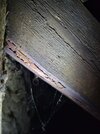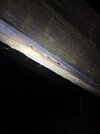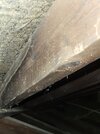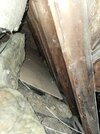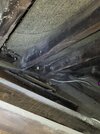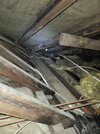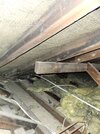Hello, I was looking in the loft of a 1900s house we've recently moved to, and noticed some tracks in the rafters that look like some kind of wood boring insect (images attached) - is that correct and is it possible to tell if old or recent? There's insulation below the beams so difficult to tell if there's fresh dust. We have some info that the timbers of the lower two floors were treated for woodworm about 30 years ago (after woodworm found under stairs on ground floor), but not the loft I don't think.
There are quite a lot of tiny light coloured bits over several beams - is this related or innocent-looking?
Also any advice on whether any rot is visible in these pictures, or mould? I am a bit worried about the whitish areas visible on some beams, especially the far ends.
We have had work done to replace flashing and broken tiles on the roof here and improve guttering, so hopefully any previous damp issues should be improving.
Thanks very much for any help!!
There are quite a lot of tiny light coloured bits over several beams - is this related or innocent-looking?
Also any advice on whether any rot is visible in these pictures, or mould? I am a bit worried about the whitish areas visible on some beams, especially the far ends.
We have had work done to replace flashing and broken tiles on the roof here and improve guttering, so hopefully any previous damp issues should be improving.
Thanks very much for any help!!


